Nof S.Y. Springer Handbook of Automation
Подождите немного. Документ загружается.

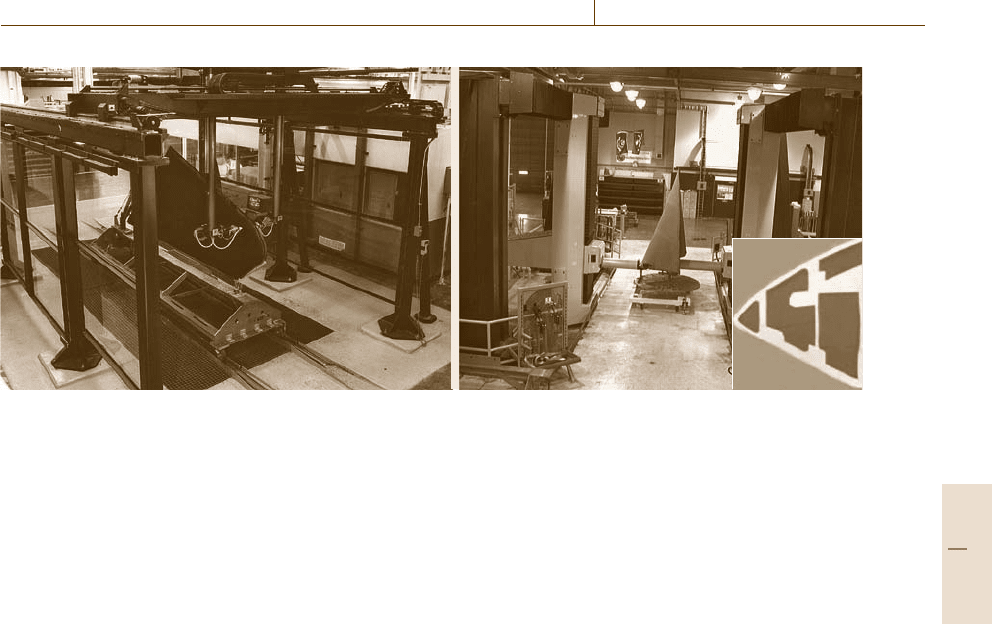
Aircraft Manufacturing and Assembly 51.4 Automated Assembly Systems/Examples 905
UT C-scan
image display
Fig. 51.17 Two types of automated ultrasonic inspection systems: independent tower system (right) and gantry system
(left) (courtesy of Boeing)
and squirter systems, where the transducer is located in
a nozzle that shoots water at a part from a short dis-
tance. The ultrasonic inspection can use one or more
transducers in a variety of combinations. The typical in-
spection uses either one transducer in pulse echo (PE)
mode, or two transducers, each aligned on opposite
sides of the part, for through transmission ultrasound
(TTU). Pitch-catch mode uses two transducers on the
same side of the part. For high throughputs using auto-
mated systems, the scanning robotics may handle arrays
of transducers that provide coverage of large areas of
material [51.16–27].
As aerospace structures become larger and more
complicated, overhead gantry systems or tower gantry
systems such as that illustrated in Fig.51.17 are used.
The overhead bridge scanning system can be used with
transducer manipulators with up to five axes of motion:
X, Y,andZ translations, rotation, and tilt. Using mo-
tion control software, the transducer can be oriented
normal to complex curved part surface during scanning.
Two transducer manipulators are employed for through
transmission imaging. The computer software can keep
the squirter transducers aligned and normal to the part
surface for complex geometric configurations. The part
geometries are taught by manual selection of a few data
points along a scan or using CAD surface data. In some
cases the systems will take pulse echo data from each
transducer on each side of the part and through trans-
mission data simultaneously. The tower scanner uses
independent machines on each side of the part to be
tested. The advantages of this configuration include the
independent surface following from each side, the im-
proved reach in capability stiffness, and reduced ceiling
height. The ultrasonic testing (UT) data from a quality
surface following scanner includes 1-to-1 flaw sizing on
complex curvature objects. The test part shown in the
tower system in Fig.51.17 is a landing gear pod fairing.
The UT C-scan image datashownin the lower-rightside
of the figure is the two-dimensional (2-D) ultrasonic
C-scan representation of the three-dimensional (3-D)
object, in which light areas indicate laminate and darker
areas indicate honeycomb core. Laminate inspections
are usually performed at 5MHz, while honeycomb is
commonly inspected with 1 or 2.25MHz ultrasound.
Inspection speeds depend on the data acquisition
rates. The data acquisition rate in X and the step size in
Y are determined by the minimum defect size that is to
be detected. Three data points are required for the mini-
mum defect size, such that 0.08in data space is used for
0.25in defect sensitivity. Many scanners and the asso-
ciated acquisition electronics can scan at up to 40in/s
while maintaining 0.04in data spacing in the scan di-
rection. Coverage of 25–50ft
2
/h is possible on many
parts.
51.4 Automated Assembly Systems/Examples
Conversion to digitally defined parts is a key factor
that has enabled the widespread use of automation.
Aircraft assembly machines are custom-designed to
meet specific requirements, where the combination
Part F 51.4

906 Part F Industrial Automation
of tight engineering tolerances, the need to reduce
part variation, and large machine envelope drives
large and expensive machines. Despite the high initial
cost, the use of automation has been very success-
ful in addressing the needs to improve quality, reduce
costs, and improve ergonomics of aircraft fabrication
and assembly. Assembly systems are designed around
the type of structures to be assembled. For single
and very large panels, C-frame riveting/fastening ma-
chines are commonly used. The most suitable system
to assemble half-shells (fuselage barrels) is a ring
riveter, and final aircraft assembly is performed man-
ually using advanced hand tools and, more recently,
newly developed, flexible, adaptable, portable assembly
systems.
51.4.1 C-Frame Fastening Machine
Automated wing panel fastening machines are used
to build stringer stiffened wing panels by riveting
stringer-to-wing skins and fastening adjacent wing
panels together. Structurally, they are large C-frames
mounted on rails that travel the length of the wing.
Floor-mounted header tooling supports the temporarily
tacked together wing panel to ensure proper panel posi-
tioning forpermanent fastener installation.The C-frame
wraps around the wing skin and applies drilling and fas-
tener installation tools to both sides of the panel. For
accurate positioning, wing riveters obtain positional ac-
curacy from the stringers mounted on the underside of
the wing panel. A typical rivet installation cycle in-
volves positioning the machine to the proper location,
clamping the skin and stringer together, drilling a hole,
inserting a rivet, hydraulically squeezing a rivet, and
shaving the formed head. Then, an electronic vision
system verifies ifthe shavedrivet meets theflushness re-
Fig. 51.18 Gemcor automated wing fastening system
quirement. Bolts are applied in a similar sequence, with
sealant beingapplied priorto boltinsertion, andthen the
nuts are installed and torqued.
A Boeing wing panel fastening system is shown in
production in Fig. 51.18. Typical production wing lines
have multiple wing assembly machines capable of op-
erating on multiple parallel rail systems with turntables
and interconnecting tracks allowing a machine to move
to work stations within the track network [51.4–8].
Machine Features
•
50000 lbs rivet upset capability to accommodate
7/16in-diameter 7050 rivets
•
Full servo programmable control including:
– High-speed upper head transfer
– High-speed drill and shave spindles
– High-speed servo buck
– High-speed servo lower head
– Servo clamp
•
Up to six upper head positions
•
Statistical process control (SPC) of fastener instal-
lation processes
•
Automatic fastener selection
•
Fastest machine cycle time in the industry
•
Standard slug squeeze process
•
Squeeze/squeeze III slug installation process
•
Vibratory insertion process for two-piece fasteners
in high interference fit conditions
•
Torque-controlled nut runner
•
Lockbolt swage collar tooling
51.4.2 Ring Riveter
for Fuselage Half-Shell Assembly
System Description
This computer-controlled riveting/fastening machine is
being used to automatically join fuselage half-shells
made from single panels along longitudinal and radial
joints as shown in Fig.51.19. It consists of:
1. Outer ring, moving on longitudinal rails, carrying
a multifunction end-effector, which moves radially
on the inside of the machine ring structure
2. A roboticarm, moving on thefloor insidethe ring on
rails longitudinally, carrying a second multifunction
end-effector
3. A flexible fixture to support the half-shell during the
assembly operations
4. Machine controller, executing assembly sequence
programs generated using an offline programming
system [51.1–3].
Part F 51.4
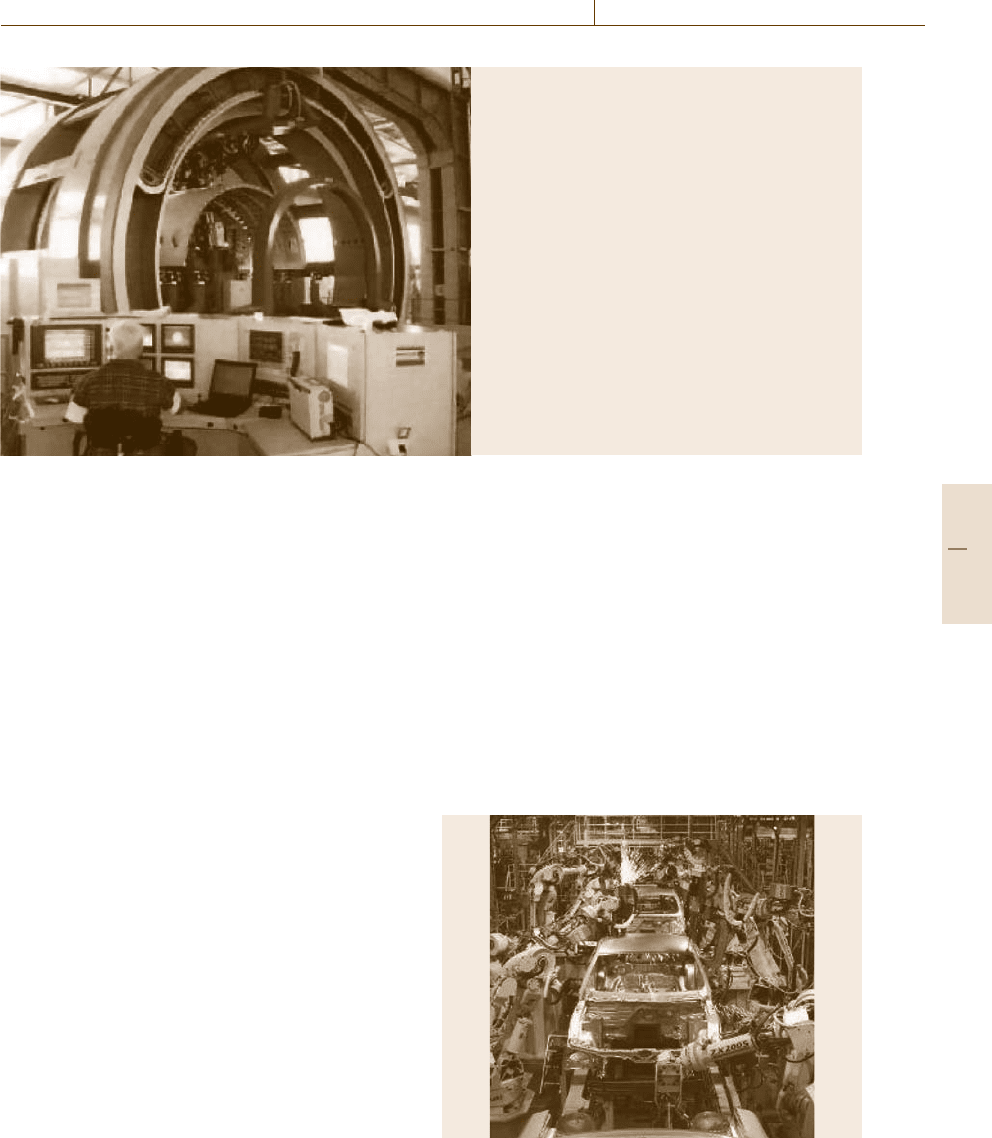
Aircraft Manufacturing and Assembly 51.4 Automated Assembly Systems/Examples 907
Technical data
• Assembly of 180° half shells
• Machine size: L = 10–80m; W = 6–12m; H = 6–10m
• Fully automated process, CNC control
• Automatic work piece transfer
• Precision rivet/fastener head position
• Solid work piece clamping during run time
• Number of rivet/fastener cassettes = 16 or more
• Drill spindle rpm = 0 to 20000
• Spindle feed = 0 to 0.006 ipr
• Pneumatic hammer for interference fastener insertion
• Rivet installation rate = 4 to 10 rivets/min
• Fastener installation rate = 2 to 6 fasteners/min
• Off-line or teach-in programming
Fig. 51.19 Ring riveter assembly system (courtesy of Broetje)
Assembly Process
Single panels and all parts building the half-shell are
tacked together and half-shell stabilized on the flexi-
ble fixture is moved into the ring’s working envelope.
The multifunction end-effector moving on the out-
side of the half-shell, and the internal multifunction
end-effector, perform synchronous riveting/fastening
operations through the skin. The outside multifunction
end-effector uses a drilling module, a rivet fastener
feeding module, and a rivet upsetting tool; and the
internal multifunction end-effector uses a clamping
tool and rivet upsetting or sleeve installation tool
module, if two-piece fasteners are being installed. Pro-
cess parameters such as the clamping force generated
by internal and external end-effector bushings at the
drilling location areadjusted forstructural material(alu-
minum, titanium, composite) and stiffness. The drill
unit’s RPM and feed force are selected as a func-
tion of hole diameter, required hole tolerance (e.g.,
0.001in) and cutter material (e.g., carbide, PCD). The
position of all machine components (ring, robot, end-
effectors) is CNC controlled and a vision system built
into the outside multifunction end-effector provides
the operator with visual control and enables precision
position adjustments if required. The internal multi-
function end-effector can be quickly decoupled from
the robotic arm and replaced with the C-frame type
of multifunction end-effector for shear tie-to-frame
riveting operations. This multifunction end-effector lo-
cates a feature (hole or rivet) on the frame, using
a vision system, and communicates information to
the robot controller, which then positions the end-
effector to the proper location for clamping, drilling,
and rivet insertion/upsetting tasks. All process param-
eters are monitored and saved to a quality-assurance
data bank to verify and document process and part
quality.
51.4.3 Airplane Moving Line Assembly
System Description
In 1913 Henry Ford put the first moving assembly
line ever used for large-scale manufacturing into use.
Fig. 51.20 Ford Motor Company moving assembly line
Part F 51.4
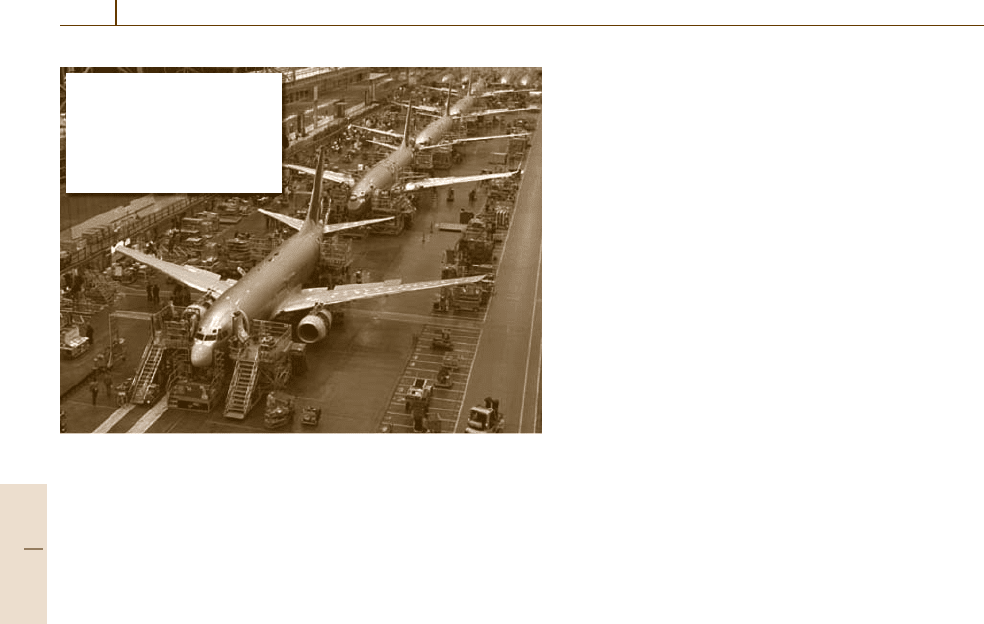
908 Part F Industrial Automation
Technical data
• Typical linear assembly line
• Line speed – 0.5" to 2"/min
• Guidance system – optical
or Hall-effect sensors
Fig. 51.21 Boeing 737 final assembly line
Ford lowered the price of a car by producing them
at record-breaking rates with this new assembly pro-
cess. Today almost all automobile manufacturers use
moving lines to assemble their products for cost, qual-
ity, and flow time reasons. In the past 5 years some
aerospace companies have moved away from tradi-
tional stationary dock assembly systems in favor of
the more efficient moving assembly lines similar to
those used in the automobile industry. State-of-the-
art examples are the Ford production line at Flatrock,
MI,USA,showninFig.51.20 and the Boeing 737
final assembly line in Renton, WA, USA, shown in
Fig.51.21.
Assembly Process
Major sections of commercial aircraft are assembled in
stationary fixtures until they are structurally stable and
need little or no support from external tools. At this
point the aircraft is placed on a barge or carrier and
begins its final assembly as it is towed by a motorized
automated tug. The tug attaches to the front of the barge
and pulls it forward under the power of a motor that
is computer controlled. Steering is accomplished by an
optical sensor that follows a white line along the floor.
Major subassemblies and components such as the
landing gear, interior systems, and passenger seats are
installed by mechanics as the airplane moves down the
assembly line. In addition, functional testing is per-
formed on the various systems in the airplane and the
engines are attached. The use of moving assembly line
can typicallyreduce the final assemblytime by 50% and
significantly reduce the number of days for this task.
The assembly time reduction is due to the application of
lean manufacturing techniques, which were introduced
into the aerospace industry in late 1999. Moving lines
help companiesachieve higherefficiencies because they
create a sense of urgency as well as streamlining and
standardizing assembly processes to eliminate waste
and nonvalue operations. Computer-controlled tugs set
the pace or takt time (the manufacturing time needed
to accomplish certain predetermined tasks). As the air-
plane moves past visible marks on the floor, teams of
mechanics install prekitted parts and tools using stan-
dard processes within the allotted time so that the next
team can continue adding value to the airplane as as-
sembly progresses [51.9–15].
51.5 Concluding Remarks and Emerging Trends
Aircraft fabrication and assembly technologies are un-
dergoing significant changes driven by the need to
achieve performance and economic targets and only
a few predominant trends are discussed here. There is
a never-ending search for higher aircraft performance,
coupled with the desire to reduce the production la-
bor content, processing time, and cost. This requires
progressiveness and innovative use of exotic mater-
ials with improved specific mechanical properties (such
as carbon-fiber composites), and development of more
efficient fabrication and assembly technologies for
metallic and nonmetallic structures. The move to more
composite aircraft mitigates some typicalproblems with
metallic parts (i. e., the shorter fatigue life and galvanic
corrosion inherent to aluminum alloys compared with
equivalent composite parts).
A majority of today’s manual high-level assem-
bly operations, such as joining fuselage barrels and
wing boxes, could be replaced in the future with
flexible, adaptable, and affordable, semi-automated as-
sembly systems to perform clamping of parts using
electromagnets, drilling, and countersinking, and fas-
tener installation tasks.
One example offering potentially significant im-
provements in assembly efficiency, is the friction stir
welding (FSW) process, developed for space launch
vehicle fabrication (for joining Delta II and IV alu-
minum panels to fuel tanks). This technology, once
Part F 51.5

Aircraft Manufacturing and Assembly References 909
thoroughly tested and approved, can be introduced into
commercial aircraft structural assembly, replacing to-
day’s time-consuming mechanical joining techniques.
The potential capability to produce high-level as-
semblies with composite structures helps to eliminate
several lower-level assembly tasks. This has been
achieved, as evidenced by the redesign of multipanel
aluminum fuselage barrels into a one-piece composite
barrel. Such moves call for development of innovative
structural configurations, and require mastering engi-
neering challenges associated with tooling, equipment,
processes, and inspection.
The emergence and growth of rapid prototyp-
ing/fabricationtechnology could revolutionizethe fabri-
cation/manufacturing of parts and assemblies. Parts will
be grown in a system that requires only the electronic
part geometry information and raw material in pow-
der form as inputs. Parts are currently created (grown)
by layered material deposition and particle fusion us-
ing lasers. These plastic net-shape, or near-net-shape,
metallic parts eliminate the need for a majority of the
material removalprocesses andreduce the material buy-
to-fly ratios and manufacturing cost. This trend could
evolve into growing substructures or even complete
aircraft segments, eliminating all part fabrication and
assembly tasks.
The trend toward monolithic metallic and large-
scale integral composite structures will probably con-
tinue in the future, and will require the development of
advanced automated fabrication and assembly systems
to meet demands for improved aircraft performance at
minimal cost. The current trend is to machine or fabri-
cate components accurately with automated machines
and then use accurately machined features in the de-
tail parts as references to build larger assemblies. At
some point, as the structure increases in size, it becomes
cost prohibitive to use conventional automation to as-
semble large parts, so the fall-back position has been to
join or splice larger assemblies manually. To capture the
benefits of automation with larger assemblies in the fu-
ture, a new generation of flexible portable automation
is being developed. These lightweight portable systems
use the aircraft structure as their foundation and will
produce quality parts at an affordable cost.
References
51.1 C. Wick, J.T. Benedict, R.F. Veilleux: Tool and Manu-
facturing Engineering Handbook – Vol. 2: Forming
(SME, Dearborn 1984)
51.2 E.H. Zimmerman: Getting Factory Automation
Right: The First Time (SME, Dearborn 2001)
51.3 J.A. Schey: Introduction to Manufacturing Pro-
cesses (McGraw Hill, New York 1987)
51.4 M. Watts: High performance machining in
aerospace, Proc. 4th Int. Conf. Metal Cutt. High
Speed Mach. (Boeing, Seattle 2002)
51.5 M. Watts: Evolving aerospace machining processes,
4th Int. Conf. High Speed Mach. – Ind. Tool. Conf.
(Southampton 2001)
51.6 L. Hefti: Innovations in fabricating superplastically
formed components, First and Second Int. Symp.
Superplast. Superplast. Form. Technol. (ASM, Ma-
terials Park 2003) pp. 124–130
51.7 D. Sanders: A production system using ceramic die
technology for superplastic forming, Superplast.
Adv. Mat. ICSAM 2003 (Trans Tech, 2004) pp. 177–
182
51.8 GEMCOR: http://www.gemcor.com (2009)
51.9 PASER: Abrasive waterjet helps make composites
affordable for Boeing, http://www.flowcorp.com/
waterjet-resources.cfm?id=251 (2008)
51.10 Boeing completes first 787 composite fuselage
section, http://www.boeing.com/companyoffices/
gallery/images/commercial/787/k63211-1.html (2005)
51.11 R.A. Kisch: Automated Fiber Placement Historical
Perspective (Boeing, Seattle 2006),
http://www.ingersoll.com/ind/tapelayer.htm
51.12 Boeing reduces 737 airplane’s final-assembly
time by 50 percent, http://www.boeing.com/news/
releases/2005/q1/nr_050127g.html (2005)
51.13 T.G. Gutowski: Advanced Composites Manufactur-
ing (Wiley, New York 1997)
51.14 S. Mazumdar: Composites Manufacturing: Mater-
ials, Product, and Process Engineering (CRC Press,
Boca Raton 2002)
51.15 F. Campbell Jr.: Manufacturing Processes for Ad-
vanced Composites (Elsevier, Amsterdam 2004)
51.16 R. Bossi, F. Iddings, G. Wheeler (Eds.): Nonde-
structive Testing Handbook, Vol. 4 – Radiographic
Testing, 3rd edn. (American Society for Nondestruc-
tive Testing, Columbus 2002)
51.17 R. Halsmshaw: Nondestructive Testing, 2nd edn.
(Edward Arnold, London 1991)
51.18 G.L. Workman, D. Kishoni (Eds.): Nondestructive
Testing Handbook, Vol. 7 – Ultrasonic Testing,3rd
edn. (American Society for Nondestructive Testing,
Columbus 2007)
51.19 ASM: ASM Handbook, Vol. 21 – Composites, Quality
Assurance (ASM, Metals Park 2001)
51.20
J. Summerscales (Ed.): Nondestructive Testing of
Fibre-Reinforced Plastics Composites,Vol.2(Else-
vier, New York 1990), pp. 107–111
Part F 51

910 Part F Industrial Automation
51.21 G.L. Workman: Robotics and nondestructive test-
ing – a primer, World Conf. Nondestruct. Test. (NDT)
(1985) pp. 1822–1829
51.22 P. Walkden, P. Wright, S. Melton, G. Field: Auto-
mated ultrasonic systems, World Conf. NDT (1985)
pp. 1822–1829
51.23 T.S. Jones: Inspection of composites using the au-
tomated ultrasonic scanning system (AUSS), Mater.
Eval. 43(6), 746–753 (1985)
51.24 M.K. Reighard, T.W. Van Oordt, N.L. Wood: Rapid
ultrasonic scanning of aircraft structures, Mater.
Eval. 49(12), 1506–1514 (1991)
51.25 Y. Bar-Cohen, P.G. Backes: Scanning aircraft struc-
tures using open-architecture robotic crawlers as
platforms with NDT boards and sensors, Mater.
Eval. 57(3), 361–366 (1999)
51.26 J.J. Gallar: Modular robotic manipulation in radio-
graphic inspection, Mater. Eval. 46(11), 1397–1399
(1988)
51.27 D. Mery: Automated radioscopic testing of alu-
minum die castings, Mater. Eval. 64(2), 135–143
(2006)
51.28 ASTM: ASTM E 1025-84, Standard Practice for Hole-
Type Image Quality Indicators Used for Radiography
Part F 51

911
Semiconducto
52. Semiconductor Manufacturing Automation
Tae-Eog Lee
We review automation requirements and tech-
nologies for semiconductor manufacturing. We
first discuss equipment integration architectures
and control to meet automation requirements for
modern fabs. We explain tool architectures and
operational issues for modern integrated tools
such as cluster tools, which combine several pro-
cessing modules with wafer-handling robots. We
then review recent progress in tool science for
scheduling and control of integrated tools and
discuss control software architecture, design, and
development for integrated tools. Next, we discuss
requirements and technologies in fab integration
architectures and operation such as modern fab
architectures and automated material-handling
systems, communication architecture and net-
working, fab control application integration, and
fab control and management.
52.1 Historical Background ........................... 911
52.2 Semiconductor Manufacturing Systems
and Automation Requirements .............. 912
52.2.1 Wafer Fabrication
and Assembly Processes .............. 912
52.2.2 Automation Requirements
for Modern Fabs......................... 913
52.3 Equipment Integration Architecture
and Control.......................................... 914
52.3.1 Tool Architectures
and Operational Requirements .... 914
52.3.2 Tool Science:
Scheduling and Control............... 915
52.3.3 Control Software Architecture,
Design, and Development ........... 919
52.4 Fab Integration Architectures
and Operation...................................... 921
52.4.1 Fab Architecture and Automated
Material-Handling Systems ......... 921
52.4.2 Communication Architecture
and Networking ......................... 922
52.4.3 Fab Control Application
Integration................................ 922
52.4.4 Fab Control
and Management....................... 924
52.4.5 Other Fab Automation
Technologies ............................. 924
52.5 Conclusion ........................................... 925
References .................................................. 925
52.1 Historical Background
The world semiconductor market has been growing
fast and amounted to US$270billion in 2007. The
semiconductor manufacturing industry has kept mak-
ing innovations in circuit design and manufacturing
technology. Some key innovations include circuit width
reductions from 1.0μm in 1985 to60nm in 2005, 40nm
in 2007, and even down to 14 nm by 2020, and wafer
size increase from 200mm to 300mm wafers, and even
to 450mm or larger in the near future. Some fabs are
producing 1Gb random-access memory (RAM)byus-
ing 50 nm technology, which reduces the cost by about
50% compared with 60 nm technology. Such technol-
ogy innovations have led to higher circuit density,
increased circuit speed, and remarkable price reduction,
which also have created new demand and expanded the
market.
In 2007, 35 new wafer fabs began to ramp up world
monthly fab capacity by two million 200mm wafers,
Part F 52

912 Part F Industrial Automation
that is, a 17% increase. A modern fab construction
costs about US$ 2 billion. On the other hand, the semi-
conductor manufacturing industry has suffered strong
competition due to excessive capacity. Therefore, the
industry has tried to reduce costs, improve quality, and
shorten the manufacturing cycle time. Automation has
been the key for such manufacturing improvement and
business success. Consequently, there have been many
aggressive technology innovations and standardizations
for fab automation. We therefore need to review those
efforts, the state of art, and the future challenges for fab
automation.
In this chapter, we briefly introduce semiconductor
manufacturing systems and automation requirements,
architecture and control for processing equipment and
material-handling systems, communication architecture
and networking, and software architecture for process
control, equipment control, and fab-wide control. We
explain academic research works as well as industrial
technologies and practices.
52.2 Semiconductor Manufacturing Systems
and Automation Requirements
52.2.1 Wafer Fabrication
and Assembly Processes
The semiconductor manufacturing process consists of
wafer fabrication and assembly. In the wafer fabrica-
tion process, multiple circuit layers (up to 30 or more)
are laid out on a wafer surface through the repetition
of identical sequences of process steps. Most fabrica-
tion process steps are chemical processes that oxidize
a wafer surface, coat photosensitive chemicals onto the
surface, expose it to a circuit image from a light source,
develop and etch the circuit pattern, deposit other chem-
icals onto it, diffuse and implant additional chemicals
on the etched pattern, and so on. Once a circuit layer
is formed, the wafer reenters the fabrication line to
form the next circuit layer. The total number of process
steps may amount to 480 or more. A wafer has several
hundreds of formed circuit devices. For strict quality
control, the formed circuits are measured by metrol-
ogy equipment frequently after some key process steps.
Based on the metrology results, some devices in a wafer
may be repaired, reworked or scrapped. Wafter yield
may be rather low, especially during the ramp-up stage
for the initial 3–6months. Wafers are transported and
loaded into processing tools using a carrier called a cas-
sette or pod that loads 25 wafers. A typical fab produces
40000 wafers each month. The fabrication cycle time is
several weeks or even a few months, depending on the
fab management performance. About 20000–100000
wafers may be in progress at any given time.
Once a wafer completes the fabrication processes,
devices on a wafer undergo intensive circuit tests called
electronic die sorting (EDS). Depending on the test
results, the devices are classified into different final
products with specifications on clock speed, number of
effective transistors, and so on. A device that fails to
satisfy the specification of a high-grade product is clas-
sified into a lower-grade product. Such a sorting process
is also called binning. Some devices may be defective.
Due to the yield problem and binning, it is difficult to
predict the number of final products of each grade or
type.
Wafers that complete EDS are sent to an assembly
or packaging plant. The fabrication processes leading
to EDS and the assembly processes after EDS are
called front-end and back-end processes, respectively.
In the back-end processes, a wafer is sliced into indi-
vidual devices. The sliced devices undergo packaging
processes that include tape mounting, wire bonding,
molding, and laser marking. The packaged devices take
final tests, where additional binning is carried out. The
back-end processeshave been regarded asrelatively low
technology with low value added and tend to be sub-
contracted. However, multichip packages (MCP)that
combine several chips together into a single package
are becoming increasingly popular due to growing de-
mand from the mobile-device industry. MCP or other
advanced packaging technologies such as wafer-scale
packaging and flip chips increase the value and impor-
tance of the back-end processes. Hence, a number of
back-end processes still involve manual material han-
dling while the front-end processes have become highly
automated. Figure 52.1 summarizes the overall semi-
conductor manufacturing processes.
A process step is performed by a number of similar
or identical wafer processing tools. Due to strict quality
requirements, some wafer lots should be processed only
with a restricted set of tools. Different types of wafer
lots flow concurrently through the fab. Therefore, the
fab can be viewed as a hybrid flow shop. Reentrant job
Part F 52.2
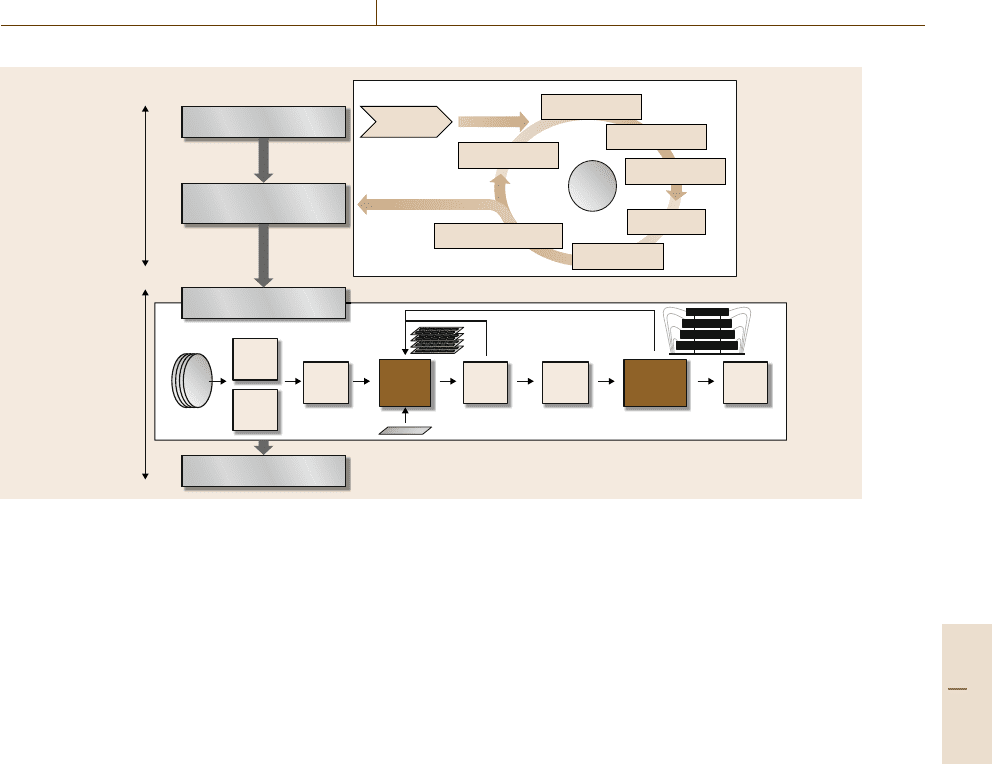
Semiconductor Manufacturing Automation 52.2 Semiconductor Manufacturing Systems and Automation Requirements 913
Die
attach
Wire
bonding
Oxidation
Wafer
Deposition
Developing
Lithography
Coating
Etch
Back
lap
Saw Cure Mold
256mb mobile Dram
1Gb N and flsh
256mb mobile Dram
1Gb N and flsh
Plasma
Tape
mount
Final test
Assembly
EDS
(Electronic die sorting)
Fabrication
Assembly
MCP
Back-end
Front-end
Diffusion/implant
Fig. 52.1 Overall manufacturing processes
flows for processing multiple circuit layers and random
yield make planning and scheduling complicated. A fab
consists of several hundreds of processing and inspec-
tion tools. The tools are grouped into bays, where each
bay consists of 10–20 processing tools. Each bay has
a stocker, where wafer cassettes are waiting for process-
ing or moving to the next bay.
52.2.2 Automation Requirements
for Modern Fabs
There are several drivers for fab automation. The
material-handling tasks in a fab are very large; for in-
stance, a fab that processes 40 000 wafers a month
requires 200 operators per shift just for moving
wafer cassettes [52.1]. Therefore, automated material-
handling systems (AMHSs) are used to reduce such
high human operator requirements. Other drivers for
material-handling automation include prevention of hu-
man’s handling errors such as wafer dropping, and
better tool utilization and reduced manufacturing cycle
time by fast and reliable material transfer [52.1]. The
keytechnological innovationsin the front-end processes
during the past decades are the continuing reduction of
circuit features for higher density and functionality, and
wafer size increase to 300mm for higher throughput.
These have led to significant fab automation. Extreme
circuit shrinkage requires strict quality control and
higher-class clean rooms to reduce increased risk of
particle contamination. As human operators are a sig-
nificant source of particle generation, the number of
operators needs to be reduced. Wafer size increase leads
to significantly heavier weight of a wafer cassette be-
yond human operator’s adequate workload. Therefore,
in recent 300 mm fabs, wafer-handling operations have
been mostly automated. Control applications for equip-
ment and AMHSs from many different vendors should
be easily integrated. Design, scheduling, and control of
fully automated fabs are highly complicated and require
new concepts and ideas (Fig.52.2).
Traditionally, wafers in a cassette have been pro-
cessed in batch mode for most chemical processes such
as etching, deposition, etc. However, as the wafer size
increases and quality requirements become stricter due
to circuit shrinkage,it becomes difficult tocontrol gasor
chemical diffusion on all wafer surfaces within a large
processing chamber to be uniform enough for strict
quality requirements. Therefore, single-wafer process-
ing (SWP) technology that processes wafers one by one
has been extensively introduced for most processes. In
order to reduce excessive moving tasks between SWP
chambers, several SWP chambers are integrated within
a closed environment together with a wafer-handling
robot. Such a system is called cluster tools.Aninte-
grated system of SWP chambers with multiple handling
robots is often called a track equipment or track sys-
tem. It can be considered as a combination of multiple
cluster tools. Cluster tools or track equipment have been
Part F 52.2
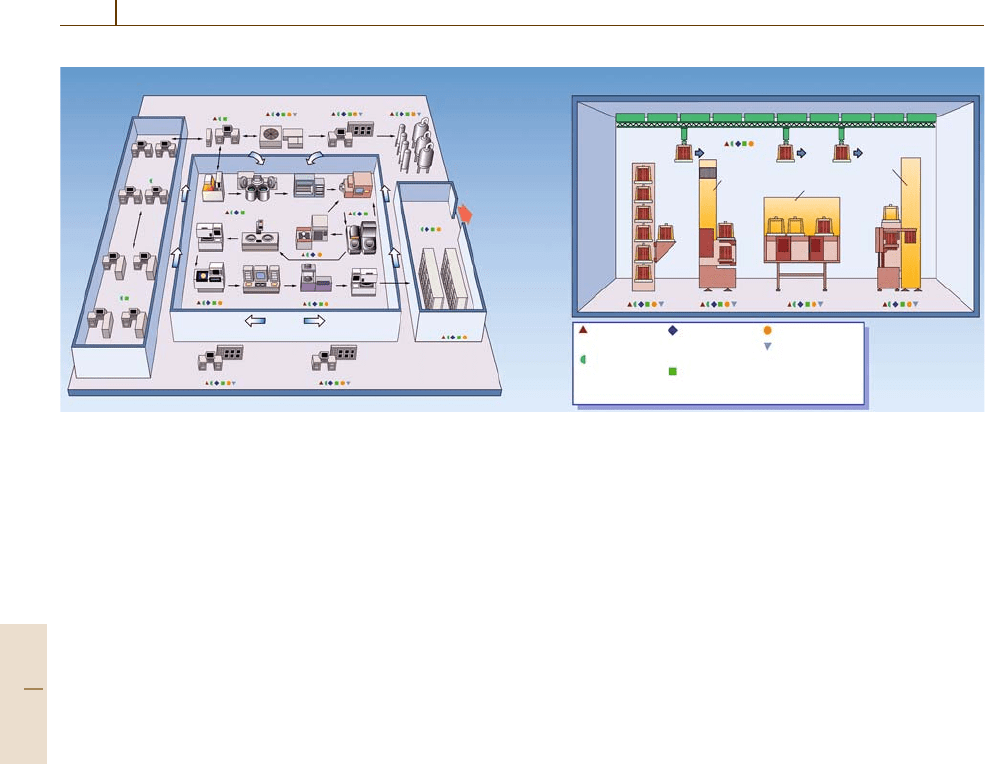
914 Part F Industrial Automation
Manufacturing execution
systems
Traditional clean room Minienvironment clean room
FMCS and HVAC
Life safety
Air Handling
CVD/PVD
Etch
Dice
Engineering
systems
Chemical distribution system
Package
Chase
Warehouse and
material handling
systems
Shipping
• Printed circuit
boards
Electronic assembly
Final test
Device attach/bond
Test Wafer probe
Oxidation
Class 100 area
Stocker
The open controller
and PLC and SLC
controllers
Operator interface
Industrial control
(Push buttons, pilot lights,
terminal blocks, relays,
contactors, switches)
Networks (Ethernet,
DeviceNet, Remote I/O,
Data Highway Plus,
ControlNet)
Reliance electric &
Allen Bradley drives
and motors and
Rockwell Automation
drive systems
Power monitoring software,
RSView32; Programming
Packages (RSQuality,
RSTrend, RSRecipe)
Process tool Process tool Process tool
Cassette handling system
Minienvironment
class 1
Minienvironment
class 1
Minienvironment
class 1
Vertical
furnace
Ion implant
photo litho
Office & business
systems
Water treatment
• PC workstations
• Consumer electronic
products
• Medical equipment
• Automobile electronic
systems
• Test and measurement
equipment
Gas dispensing system
Fig. 52.2 Semiconductor fabrication clean rooms (courtesy of Rockwell Automation, Inc.)
increasingly used formost processes. Dueto the internal
complexity and restrictions, they pose scheduling and
control challenges. First, their operations should be op-
timized to maximize throughput. Second, wafer delays
within a processing chamber after processing should be
controlled because residual gases and heat affect wafer
quality significantly. Third, the tool controller should be
reliable and easily adaptable for different tool config-
urations and changing wafer flow patterns or recipes.
Scheduling and control, and tool application integration
are not trivial.
Another important issue for fab automation is
standardization for reducing integration effort and per-
formance risk. Semiconductor Equipment and Material
International (SEMI), an international organization, has
developed extensive standards on architectural and in-
terface standards of material-handling hardware, com-
munication, and control software for fab automation.
The standards themselves are based on state-of-the-art
automation technologies; however, they should be con-
tinuously improved for higher operational goals and
changing automation requirements.
52.3 Equipment Integration Architecture and Control
52.3.1 Tool Architectures
and Operational Requirements
In a cluster tool, there is no intermediate buffer between
the process modules (PMs). A wafer, once unloaded
from a loadlock, can return to the loadlock only af-
ter it completes all required process steps and is often
cooled down at a cooler module, if any. This is because
a hot wafer returned to the wafer cassette at the load-
lock may damage other wafers there and a hot wafer in
progress should not be excessively cooled down before
processing at the next PM. A wafer loaded into a PM
immediately starts processing since the PM’s chamber
already has gases and heat. There are different cluster
tool architectures, as illustrated in Fig.52.3. Most tools
have radial configurations of chambers, where robot
move times between chambers are minimized. Linear
configurations are also considered to add or remove
chambers flexibly. The robot has a single arm or dual
arms. The dual arms keep opposite positions. Dual-
armed tools are known to have higher throughput than
single-armed tools [52.2]. There are also tools with in-
termediate vacuuming buffers between chambers and
loadlocks [52.3] in order to save vacuuming and vent-
ing times at the chambers. Some new cluster tools use
multiple wafer slots in a chamber in order to improve
throughput above that of SWP tools by processing sev-
eral wafers together [52.4]. However, those new tool
architectures tend to increase scheduling complexity
significantly.
Track equipment or systems are also widely used
for integrating several process steps. Photolithography
processes use track systems that supply steppers with
wafers coated with photosensitive chemicals and de-
Part F 52.3
